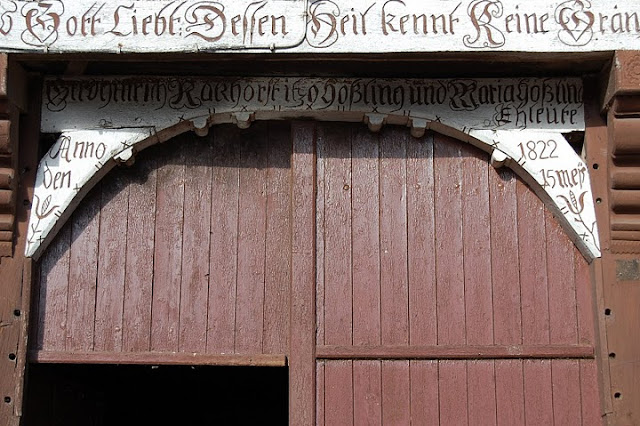
 One of the things that was most surprising to us was how the Heuerleute (non-landowning workers) live. Often they lived in what was called the Heuerhaus. This was often not much more than a barn that housed the farm animals as well as one or two families of workers. We were able to see one of the two Heuerhauses of the Lampe-Gossling farm. The one that is pictured with a red arrow, points out the location of the "haus" that had burned down and been replaced by a modern building. The black and white pictures were taken in 1930, fifty years after the Vonderheides emigrated.
One of the things that was most surprising to us was how the Heuerleute (non-landowning workers) live. Often they lived in what was called the Heuerhaus. This was often not much more than a barn that housed the farm animals as well as one or two families of workers. We were able to see one of the two Heuerhauses of the Lampe-Gossling farm. The one that is pictured with a red arrow, points out the location of the "haus" that had burned down and been replaced by a modern building. The black and white pictures were taken in 1930, fifty years after the Vonderheides emigrated.We were able to see first-hand the surviving Heuerhaus, just down the street from the center of town and the Church. I am pictured with Werner and Mayor Bernard Echtermann who graciously toured the town with us.

Werner explained to us that each completed building included a carving by the main builder/architect. If you notice, you can see that this building was constructed in 1822.

We opened the door to the building and viewed what had been stalls for the farm animals. The farm owner lives in a thoroughly modern home and this building now functions as an outbuilding. I'm sure 150 years ago, the floor was not concrete.

The original hand-hewn beams are visible and a tribute to the architecture of the time.

Not far from Holdorf in Cloppenburg (about 30 miles) an outdoor museum is located where many of the buildings from that era have been moved and preserved. It includes windmills, carriages, farm equipment, and living spaces so that visitors can visualize just how people of the time lived. I was especially interested in the kitchen area. Pictured below is one example of a kitchen built at one end of a Heuerhaus. Fire was a constant threat.

One common site throughout this area of Germany was a shrine with a crucifix as if the farmers were asking God's blessing upon their farms and homes. The Lampe-Gossling Farm was no exception. Here is their shrine, just outside the current family home.

Note: The black and white pictures on this post and several that follow are taken from a book on the history of Holdorf called Die Gemeinde Holdorf im Wandel der Zeit, ISBN: 978-3-86595-162-5 http://www.geigerverlag.de
The Meire Grove Band from central Minnesota went to Holdorf to help celebrate its 150th Schuetzenfest. The Meyer family emigrated from Holdorf in 1855-1856, and 20 of the 60 travelers were descendants of the Meyer family. Many others have relatives in Dinklage, Damme, Ankum, Steinfeld, etc. Bernard Echtermann was a gracious host and also gave us a tour, showing us the original Meyer farm and Corpus Christi chapel that is still there. We also was the Heuerhaus. The mayor Dr. Wolfgang Krug also held a reception for us in the City Hall. This was the best trip we ever had and we thank the Germans very much and await their trip to Meire Grove, Minnesota!
ReplyDeleteI am so glad that you, too, were the recipient of such gracious hospitality. What a welcoming group they are! I shouldn't be surprised that your town has a band. It seems to be a tradition in "our" part of Germany. One night we heard music where we were staying. Upon investigation, it was the Holdorf Band holding practice in one of the back rooms of our small hotel. Thanks for posting.
ReplyDelete